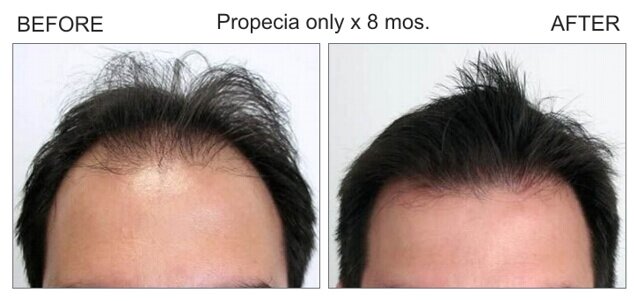
If you are going to take drugs based on finasteride for the treatment of alopecia, first of all, you need to consult your physician and trichologist. Finasteride should not be taken by women and children.
What is finasteride?
Finasteride — is a remedy to stop hair loss. Sometimes finasteride allows growing new terminal hair, but it happens rarely. It is believed that the main task is to stop further baldness. This drug is taken in pill form and it is ingested each day.
The medication is based on Finasteride Propecia which is approved for use by the Department of quality control of products and medicines of the USA (FDA (Food and Drug Administration) or USFDA – a government agency which is subordinate to the Ministry of health of the United States).
This is one of two drugs approved by the FDA for the treatment of baldness.
What are the names of drugs based on finasteride?
The only drug on the basis of finasteride to stop hair loss is Propecia. Each tablet of this drug has 1 mg of finasteride. The drug is taken at the dosage of 1 tablet per day.
How does it work?
Propecia finasteride gets in the bloodstream, begins to contact with 5-alpha-reductase of the 2nd type instead of testosterone, thus not allowing the testosterone to be converted to dihydrotestosterone.
What is the 5-alpha-reductase of the 2-nd type?
5-alpha-reductase — is an enzyme of a man which converts the male sex hormone testosterone to the more potent androgen dihydrotestosterone, and is also involved in the formation of neurosteroids allopregnanolone and THDOC. Thus, reducing the amount of 5-alpha-reductase (via linking with Finasteride), the total number of dihydrotestosterone is also reduced. So, Finasteride and is used to decrease the concentration of dihydrotestosterone in the body.
What is dihydrotestosterone?
Dihydrotestosterone is the biologically active form of testosterone, which is formed from in the cells of target organs under the influence of the enzyme 5-alpha-reductase. Dihydrotestosterone binds to androgen receptor tissues much stronger than the parent compound (testosterone). The increased formation of dihydrotestosterone in hair follicles is associated with excess of hair on the body and/or male pattern baldness on the head of both sexes. Dihydrotestosterone performs the following functions:
- Stimulates the secretion of skin oil glands
- Stimulates cell division in the prostate
- Stimulates or inhibits the growth of hair on certain parts of the body
- Stimulates the growth of genital organs of men at puberty
- Affects erectile function of men (a desire, while testosterone is responsible for erection)
- Presumably affects recovery after heavy physical exertion
So, generic Propecia reduces the amount of dihydrotestosterone, but will it affect the body?
The reception of Propecia finasteride will decrease the level of DHT, which will remain at this reduced level until you stop taking the drug. The level of testosterone increases (maximum 10%) to compensate the decrease of dihydrotestosterone. Gradually, the concentration of dihydrotestosterone in hair follicles is reduced, as it is required for the treatment.
How long should you take finasteride?
While you are taking Propecia finasteride and buy Propecia online, it works. If you stop taking it, then the effect will be stopped. Cheap Propecia should be taken while you value the hair, that is a lifetime (or until you come up with new, more efficient vehicle).
When will you see the first results?
The first results can be observed in 6-12 months after you buy Propecia online. In very rare cases the improvement may appear within 3 months.
The third phase of generic Propecia trials was conducted for several years. 60 dermatological clinics were involved in the trials (33 of them were in the USA) and 1533 volunteers. 1,215 volunteers continued to participate in the testing of cheap Propecia in the second year. The age of participants was 18-41 years. Degree of baldness according to the Norwood was 3-5. All participants took 1 mg of Propecia or a placebo every day.
Objective and subjective indicators were used for evaluation of the results. Subjective analysis included a survey of the participants about the results of treatment. Objective analysis included measurement of density and thickness of the hair, the duration of the anagen phase and other indicators.
Subjective and objective indicators were assessed by dermatologists who did not know what participants were taking (Propecia or placebo).